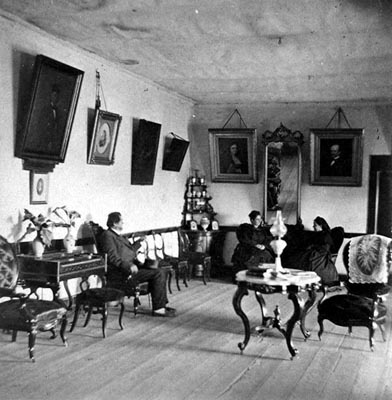‘What did the interiors of homes look like in the early days of Santa Barbara?’
-Rich Cooper

This is not an easy question to answer. First of all, the visual record is slight; the Spanish and Mexican eras pre-date photography, so one has to largely depend on the observations of diarists, travel writers, private correspondence, and records such as cargo manifests and supply requests. Secondly, just as in the homes of today, interiors and furnishings differed widely depending on economic class and social standing. The home of a wealthy ranchero would look quite different from that of an artisan or laborer.
Alta California was sparsely populated in the period 1782-1846. In 1790, there were only about 1,000 colonists in the entire region, and by 1846, just before the American conquest of California, there were only around 7,500 inhabitants who were not Native Americans. Since the majority of these settlers came from northwestern Mexico, it is understandable that the homes they built here would resemble those they had left behind, especially considering that the climates of the two regions are somewhat similar.
Adobes were characterized by thick walls and roofs of tile or thatch. Outside walls were coated with lime to protect them from the elements and interior walls were also often whitewashed as well. Windows were usually small. Glass was virtually unknown so windows were covered with oiled paper or cowhides. Wooden bars might afford additional security, but were not seen on more modest dwellings. Floors were usually packed earth; wooden floors were uncommon.
The adobe home of a family of modest means usually had two rooms. One would act as the living room and, sometimes, the kitchen. The second room would be the sleeping area. Depending on the size of the family, this room might be divided by blankets or hides to afford some privacy. More often than not, the cooking area was located outside the house. Families spent a good deal of time outside and would often eat their meals near the cooking areas instead of inside. The mild climate undoubtedly played a role in this practice.
To the modern eye, furnishings were meager. Part of the problem was supply. Some furniture was shipped from San Blas, Mexico, but with the beginning of the Mexican revolt against Spain in 1810 and subsequent weakening of Spanish authority, the supply ships stopped coming. Spain officially forbade trade with foreign powers; thus smuggling flourished from the early 1800s until Mexican independence in 1822, but this illicit trade never did match demand.
An important source of manufactured furniture was the mission with its community of Chumash neophyte labor. The mission produced rough-hewn benches, tables, and chairs, but even these were sometimes out of economic reach, especially after Spain suspended military pay in Alta California after 1810. Settlers were left to their own devices. Sometimes benches were cut into adobe walls. Chairs were fashioned from whale vertebrae. Beds were made out of wood framing and cowhides. Sometimes the bed was simply a hide laid upon the ground. Pillows were stuffed with straw.
Dishes were usually made of unfired clay. Metal eating utensils were for the well-off; wooden spoons were crafted or sometimes they were made of bone. A rolled tortilla was a perfectly serviceable spoon for many. Most families would also have some sort of trunk for storage that could be used to transport belongings if need be.
Trade opened up after 1822, and, as more settlers arrived in coming decades, shipments of imported furniture increased. In the first 30 years of European settlement here, however, settlers were largely left to carve out a rather meager lifestyle for themselves.



